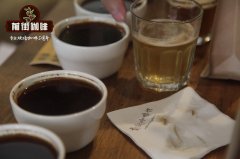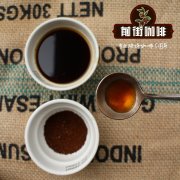Guatemala | San Macro San Marcos Manor ACUPDIC&APCASA Cooperative SHB Sun Bean

Professional coffee knowledge exchange more coffee bean information please follow the coffee workshop (Wechat official account cafe_style)
Guatemala | San Macro San Marcos Manor ACUPDIC&APCASA Cooperative SHB Sun Bean flavor?
San Marcos is the city of Guatemala and the capital of San Marcos province. Founded in 1533, it covers an area of 121 square kilometers. It is located in the southwest of the country, 252 kilometers from the capital Guatemala City, west of Mexico and south of the Pacific Ocean. Mount Tahumurko, the highest peak in the country, is located in this province. The ACUPDIC and APCASA Cooperative Farmers' Union for Peace and Social Development (ACUPDIC) and the Santa Anita Coffee producers Association (APCASA) are located in the San Marcos region of Guatemala at 2398 metres above sea level. The two villages were created after the civil war in Guatemala, when guerrillas bought coffee fields as part of the Peace Agreement in the early 1990s. Villages are remote and hard to reach, making poverty and food insecurity common. In total, there are two cooperatives with about 126 members. Farmers are usually small farmers, each with an average of about 5-10 acres of land. All coffee is hand-cultivated and hand-processed.
In ancient times, violent volcanic eruptions created the terrain of Guatemala's mountains, plateaus and large amounts of water resources, which is now the coffee-producing area. Located in San Marcos, Santa Maria erupted in 1902 with the largest eruption since the 20th century and the largest eruption in Central America in a thousand years. A large amount of volcanic ash blocked out the sun and caused the global temperature to drop by half a degree. All coffee farms are buried in volcanic ash, causing coffee production to fall by 75%. It takes 20 years to recover, but it also has rich volcanic soil.
The volcano San Marcos is the warmest and highest rainfall of the eight coffee-producing regions in Guatemala, and it is also the first region to bloom. During the rainy season from the end of April to mid-November, the annual rainfall in some areas can even reach 200 inches. Due to climatic conditions and unexpected rainfall, most estates have their own washing plants, and then leave the coffee in the yard to semi-dry and then dry at a low temperature.
Using the subtle floral aromas of coffee varieties Bourbon,Catuai,Caturra and Catimor, the unique acidity and apparent consistency of the San Marcos region is the hottest of the eight coffee-growing areas in Guatemala, with the highest rainfall of 200inches (5000 mm) and an average humidity of 70-80%. Seasonal rainfall is faster than in other areas, producing the earliest coffee plants to bloom. The northern part of the Ministry is a mountainous area, the mountains are crossed by the Madre Mountains, and the two highest volcanoes in Central America are located within their boundaries and are micro-climate producing areas. Sweet wine, dark chocolate taste, peach-like sweetness, manual picking, 14 days of sun peeling and shelling, retaining the complete flavor of peel and pulp.
Products: Catimor, Iron pickup, Bourbon, Kaddura (Caturra), Kadui Catuai
Grade: SHB EP
Producing area: San Marcos (San Macro)
Sea pull: 1600 m
Temperature: 21-27 ℃
Relative humidity: 70-80%
Harvest season: December-March
Soil: volcanic soil
Exquisite way: sun treatment
Special color: wine, peach, plum fruit
Qianjie recommended cooking:
Filter cup: Hario V60
Water temperature: 90 degrees
Degree of grinding: small Fuji 3.5
Cooking methods: the ratio of water to powder is 1:15, 15g powder, the first injection of 25g water, 25 s steaming, the second injection to 120g water cut off, waiting for the powder bed water to half and then water injection, slow water injection until 225g water, extraction time about 2:00
Analysis: using three-stage brewing to clarify the flavor of the front, middle and back of the coffee. Because the V60 has many ribs and the drainage speed is fast, it can prolong the extraction time when the water is cut off.
Important Notice :
前街咖啡 FrontStreet Coffee has moved to new addredd:
FrontStreet Coffee Address: 315,Donghua East Road,GuangZhou
Tel:020 38364473
- Prev

Indonesia semi-washed Sumatran Coffee recommended _ spruce Red Fruit Mantenin hand pulping parameters sharing
Professional coffee knowledge exchange more coffee bean information please follow the coffee workshop (Wechat official account cafe_style) MANDGELING G1 Sumatra red fruit Manning country: Indonesia Origin: Lake Tawer,Gayo Mountain coordinates: Jiagong Jagong beans: Arabica Manning Mandheling,Arabica,Typica,Timtim,Ateng,a
- Next

How to drink Emerald Manning Coffee in Lake Tawa, Indonesia. The difference between Emerald Manning and Manning
Professional coffee knowledge exchange more coffee bean information please follow the coffee workshop (Wechat official account cafe_style) Indonesia Coffee-Lake Tawa, Sumatra Emerald Mantenin Indonesia Sumatra Lake Tawar Gayo Mandheling production area: Lake Tawar, Sumatra, Origin: Aceh growing region, northwestern Sumatra
Related
- Detailed explanation of Jadeite planting Land in Panamanian Jadeite Manor introduction to the grading system of Jadeite competitive bidding, Red bid, Green bid and Rose Summer
- Story of Coffee planting in Brenka region of Costa Rica Stonehenge Manor anaerobic heavy honey treatment of flavor mouth
- What's on the barrel of Blue Mountain Coffee beans?
- Can American coffee also pull flowers? How to use hot American style to pull out a good-looking pattern?
- Can you make a cold extract with coffee beans? What is the right proportion for cold-extracted coffee formula?
- Indonesian PWN Gold Mandrine Coffee Origin Features Flavor How to Chong? Mandolin coffee is American.
- A brief introduction to the flavor characteristics of Brazilian yellow bourbon coffee beans
- What is the effect of different water quality on the flavor of cold-extracted coffee? What kind of water is best for brewing coffee?
- Why do you think of Rose Summer whenever you mention Panamanian coffee?
- Introduction to the characteristics of authentic blue mountain coffee bean producing areas? What is the CIB Coffee Authority in Jamaica?

